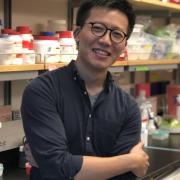
Xiao Gao
I joined the Chaumeil Lab as a Staff Research Associate in November 2019 and right now I am a Ph.D. candidate of UC Berkeley-UCSF Joint Program in Bioengineering. My research interest is pointed at the heterogeneities of different brain regions in terms of their cellular composition, neurotransmitter release, and metabolic signature. More specifically, I am very fond of exploring the horsepower of high-field MRI techniques in detecting the structural/metabolic characteristics of each part of the brain and their dynamic changes in various physiological and pathological situations, like strokes, neurodegenerative diseases, and vascular dementia. On top of that, nowadays the thriving community of neuroscience is open-sourcing massive data at different biological levels from transcriptome, to connectome and to epidemiology, and I am working on leveraging such multi-dimensional/disciplinary informatics power to better interpret our neuroimaging findings and hopefully vice versa.
I received my MBBS from Shanghai Medical College, Fudan University in China, after finishing 4-year theoretical training and 1-year bedside practice. Following that, I joined the Master program in Neurosurgery of Shanghai Huashan Hospital, Fudan University, where my research looked into the inflammatory changes of astrocytes and the protective role played by calcium channel blocker Nimodipine after the attack of Arterial Subarachnoid Hemorrhage. More recently, I received my MSc degree in Biomedical Imaging at UCSF and worked on big data approaches in Alzheimer’s Disease in the Raj lab at the Department of Radiology and Biomedical Imaging, UCSF.
As I am wandering more and more (readily) on the preclinical side of neuroscience, I hold my attention to any potential clinical translation of our imaging techniques, in hope of making the screening more approachable and the surgery more accurate. On the other hand, I find it really useful going over the latest clinical guidelines to clarify the urgent/key questions lacking the input from laboratories. As part of my leisure activities, I fancy sketching and photographing as an interesting way of meditation and reflection.
